Ethereum
Ethereum Founder Buterin Lays Out Possible Futures For ETH

In a blog post released on October 14, Ethereum co-founder Vitalik Buterin outlined potential future enhancements for the Ethereum protocol, focusing on technical improvements to its proof-of-stake (PoS) system. Titled “Possible futures of the Ethereum protocol, part 1: The Merge,” the post delves into strategies to improve stability, performance, and accessibility while addressing centralization risks.
First, Buterin reflects on Ethereum’s successful transition from proof-of-work to proof-of-stake aka “The Merge” nearly two years ago, noting that “this proof of stake has performed remarkably well in stability, performance and avoiding centralization risks.” However, he emphasized that “there still remain some important areas in which proof of stake needs to improve.”
Future Enhancements For Ethereum
One of the primary focuses of the post is achieving single slot finality and reducing the minimum staking requirement to democratize participation in the network. Currently, it takes 2-3 epochs (approximately 15 minutes) to finalize a block, and a minimum of 32 ETH is required to become a validator. Buterin highlights the conflict between minimizing the staking requirement, reducing finality time, and minimizing node overhead.
“Today, it takes 2-3 epochs (~15 min) to finalize a block, and 32 ETH is required to be a staker,” he wrote. He identified the goals of finalizing blocks in one slot and allowing validators to stake with as little as 1 ETH. “Poll after poll repeatedly show that the main factor preventing more people from solo staking is the 32 ETH minimum,” Buterin notes.
To address these challenges, he discusses several approaches. One involves implementing better signature aggregation protocols, potentially using zero-knowledge proofs (ZK-SNARKs), to process signatures from millions of validators in each slot. Another approach is the introduction of Orbit Committees, a mechanism where a randomly selected medium-sized committee finalizes the chain while preserving the cost-of-attack properties. “Orbit takes advantage of pre-existing heterogeneity in validator deposit sizes to get as much economic finality as possible, while still giving small validators a proportionate role,” he explains.
Buterin also considers creating a two-tiered staking system with different deposit requirements, where only the higher-deposit tier is directly involved in providing economic finality. He acknowledges that “the risks depend heavily on the specific rights that the lower staking tier gets,” and that certain designs could lead to centralization.
Addressing security vulnerabilities related to Denial-of-Service (DoS) attacks on known validators, Buterin proposes the implementation of Single Secret Leader Election (SSLE) protocols. “The best way to fix the DoS issue is to hide the information about which validator is going to produce the next block, at least until the moment when the block is actually produced,” he states.
SSLE protocols use cryptographic techniques to create “blinded” validator IDs, ensuring that only the owner of a blinded ID can generate a valid proof to propose a block without others knowing their identity. However, Buterin acknowledges the challenges: “We highly value Ethereum being a reasonably simple protocol, and we do not want complexity to increase further. SSLE implementations that we’ve seen add hundreds of lines of spec code, and introduce new assumptions in complicated cryptography.”
He also explored methods to reduce Ethereum’s transaction confirmation time from the current 12 seconds to as low as 4 seconds, emphasizing the value of decreasing confirmation times for improving user experience and aiding decentralized Layer 2 solutions. Strategies include reducing slot times and allowing proposers to publish pre-confirmations over the course of a slot. However, Buterin cautions about potential centralization risks and the need for proper incentives, noting that “if we add an attester-proposer separation mechanism, then execution blocks will not need SSLE, because we could rely on block builders being specialized.”
Buterin also touches on additional critical areas, including 51% attack recovery. He suggests that while full automation is impossible, “we can achieve partial automation […] ensuring that the bad guys in an attack at least cannot get a quick clean victory.” He also considers increasing the quorum threshold for block finalization from 67% to 80% to enhance security, arguing that “this seems a much healthier situation than ‘the wrong side’ getting an instant victory.”
Concluding his blog post, Buterin warns of the importance to prepare for the potential threat of quantum computers capable of breaking current cryptographic systems: “This justifies conservatism in the assumptions around performance of proof-of-stake designs, and also is a cause to be more proactive to develop quantum-resistant alternatives.”
At press time, ETH traded at $2,524.
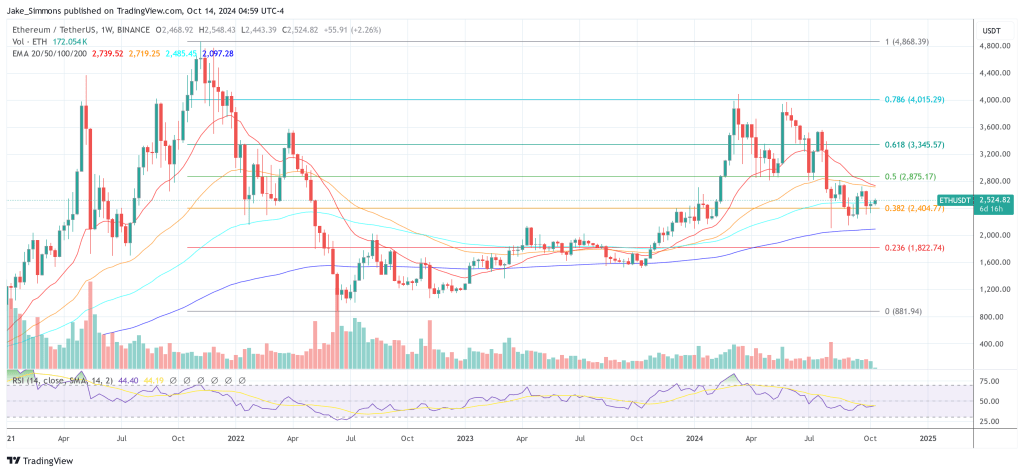
Featured image from Bloomberg, chart from TradingView.com
Ethereum
Ethereum Trading In ‘No Man’s Land’, Breakout A ‘Matter Of Time’?

Reason to trust

Strict editorial policy that focuses on accuracy, relevance, and impartiality
Created by industry experts and meticulously reviewed
The highest standards in reporting and publishing
Strict editorial policy that focuses on accuracy, relevance, and impartiality
Morbi pretium leo et nisl aliquam mollis. Quisque arcu lorem, ultricies quis pellentesque nec, ullamcorper eu odio.
Ethereum (ETH) continues failing to reclaim the $2,100 resistance, dropping 6% in the past week. As the second largest crypto trades within its “make or break” levels, some market watchers suggest it will continue to move sideways before another major move.
Related Reading
Ethereum Trades At 2023 Levels
After closing its worst Q1 since 2018, Ethereum continued moving sideways, hovering between the $1,775-$1,925 price range. Amid last Monday’s recovery, Ethereum traded only 6% below its monthly opening, eyeing a potential positive close in the monthly timeframe.
Nonetheless, the cryptocurrency fell over 10% from last week’s high to close the first quarter 45.4% below its January opening and 18.6% from its March opening. Moreover, it registers its worst performance in seven years, recording four consecutive months of bleeding for the first time since 2018.
Daan Crypto Trades noted that ETH is “still trading in no man’s land” despite its recent attempts to break above its current range. In early March, Ethereum dropped below the $2,100 mark, losing its 2024 gains and hitting a 16-month low of $1,750.
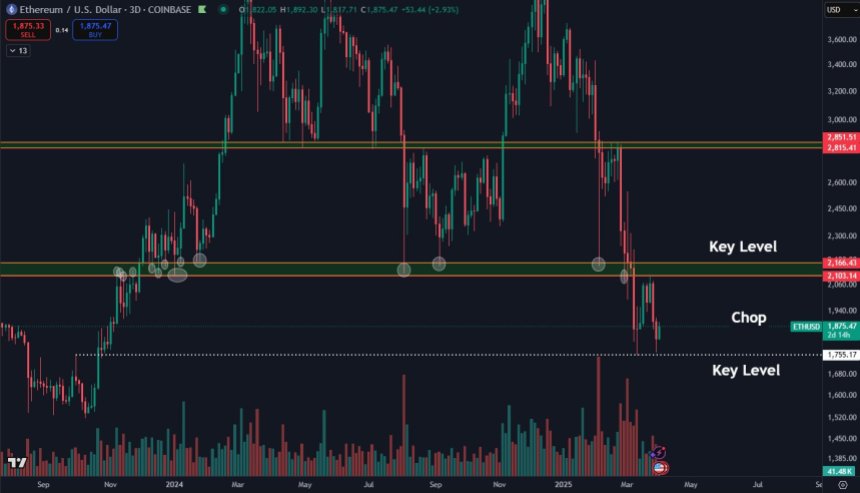
The trader suggested that the crucial levels to watch are a breakdown below $1,750 or a breakout above $2,100. “Anything in between is just going to be a painful chop,” he added.
Another market watcher, Merlijn The Trader, highlighted that ETH is at 2021 levels, pointing that it is trading within the breakout zone that led to Ethereum’s all-time high (ATH) but has stronger fundamentals and more institutional demand four years later.
“ETH is sitting on the same monthly support that ignited the 2021 bull run. Hold it, and $10K is in play. Lose it… and things get ugly,” he detailed.
More Chop Before ETH’s Next Move?
Analyst VirtualBacon considers that Ethereum will continue to trade within its current price range for the time being. He explained that ETH’s price has fallen to retest the last bear market resistance levels, as it has erased all its gains since November 2023.
The analyst considers this zone a “good value range” but doesn’t expect the cryptocurrency to break out “right away.” However, he added that a bullish breakout is “simply a matter of time” in longer timeframes.
“Ethereum always catches up when the Fed pivots and the global liquidity index beings to uptrend. That’s when you see the ETH/BTC ratio start to turn up again, leading the rest of the altcoin market,” he concluded.
Related Reading
Ali Martinez pointed out that the number of large ETH transactions has significantly declined in over a month, dropping 63.8% since February 25.
During this period, large transactions fell from 14,500 to 5,190, signaling a drop in whale activity on the network. He also noted that whales have sold 760,000 ETH in the last two weeks.
As of this writing, Ethereum trades at $1,903, a 6% drop in the weekly timeframe.
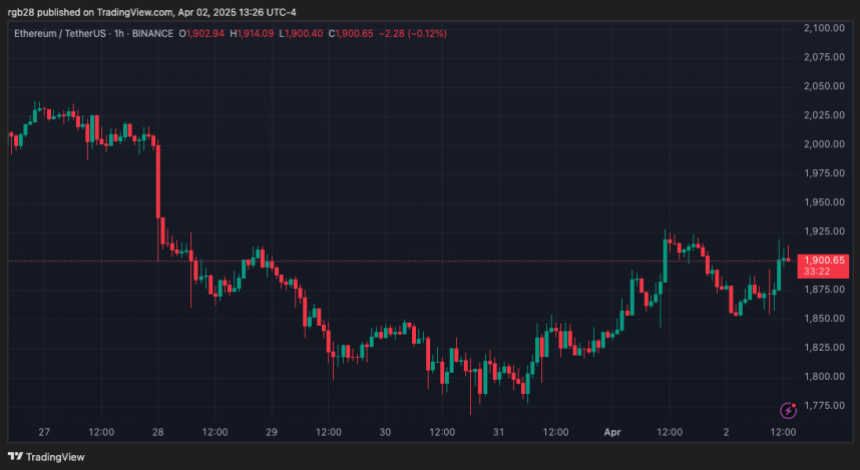
Featured Image from Unsplash.com, Chart from TradingView.com
Ethereum
Why A Massive Drop To $1,400 Could Rock The Underperformer

Reason to trust

Strict editorial policy that focuses on accuracy, relevance, and impartiality
Created by industry experts and meticulously reviewed
The highest standards in reporting and publishing
Strict editorial policy that focuses on accuracy, relevance, and impartiality
Morbi pretium leo et nisl aliquam mollis. Quisque arcu lorem, ultricies quis pellentesque nec, ullamcorper eu odio.
Crypto analyst Klejdi has indicated that Ethereum’s pain is far from over, with the second-largest crypto by market cap set to suffer a further downtrend. Specifically, he warned that ETH could still drop to as low as $1,400 before it finds a bottom.
Ethereum May Still Drop To As Low As $1,400
In a TradingView post, Kledji stated that Ethereum may drop to $1,400, providing a bearish outlook for the altcoin, which has underperformed other top cryptocurrencies. The analyst noted that ETH lost nearly 12% of its value within just three days after breaking out of its recent pattern last Friday.
Related Reading
He further mentioned that Ethereum’s movement and the rest of the crypto market are closely tied to Bitcoin. As such, this ETH crash is likely to happen, seeing as the flagship crypto has dropped to $81,300 and is already showing signs of further decline.
Klejdi highlighted in his accompanying chart that ETH will likely consolidate near its current level before continuing to move lower. However, the chart showed that the move to this $1,400 target will likely happen this month.
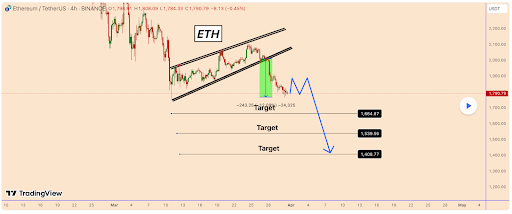
In the meantime, the analyst believes it would be wise to wait for Ethereum’s price to form another bearish pattern before entering a trade. He again reaffirmed that there is a strong possibility that ETH may extend its drop to $1,400.
Ethereum whales are already capitulating ahead of this projected price crash. Onchain analytics platform Lookonchain revealed an ETH OG that has sold off all its holdings. This investor bought 5,0001 ETH while trading at $277 in 2017 and didn’t sell when the altcoin hit its ATH during the last bull run. The whale started selling last month, possibly giving up on Ethereum making a comeback anytime soon.
ETH Will Still Reach New Highs
Crypto analyst Virtual Bacon is still confident that Ethereum will reach new highs. He noted that ETH is back at its key bear market breakout zone, retesting the $1,700 and $2,100 range. He predicts that the altcoin will continue to chop around this range in the short term. However, he remarked that Ethereum tends to catch up fast once the US Federal Reserve pivots and global liquidity turns.
Related Reading
Crypto analyst Crypto Patel affirmed that Ethereum’s biggest run is coming. He stated that Q2 to Q4 of this year will be life-changing for ETH. The analyst added that this could be the cycle top window and advised market participants not to miss it. Crypto Patel advised that they should accumulate between $1,900 and $1,300 with the target of between $7,000 and $10,000 in mind.
At the time of writing, the Ethereum price is trading at around $1,850, up in the last 24 hours, according to data from CoinMarketCap.
Featured image from iStock, chart from Tradingview.com
Ethereum
Whales Dump 760,000 Ethereum in Two Weeks — Is More Selling Ahead?

Reason to trust

Strict editorial policy that focuses on accuracy, relevance, and impartiality
Created by industry experts and meticulously reviewed
The highest standards in reporting and publishing
Strict editorial policy that focuses on accuracy, relevance, and impartiality
Morbi pretium leo et nisl aliquam mollis. Quisque arcu lorem, ultricies quis pellentesque nec, ullamcorper eu odio.
Ethereum continues to face strong headwinds as it trades below the $1,900 mark, with bullish momentum fading and market sentiment growing increasingly fearful. After a brief attempt to stabilize, ETH has resumed its downward trajectory, now down over 35% since late February. Price action remains weak, and investors are bracing for more potential downside as selling pressure shows no sign of easing.
Related Reading
Contributing to the bearish outlook, on-chain data from Santiment reveals that whales have offloaded approximately 760,000 ETH in just the past two weeks. This significant sell-off by large holders adds weight to the growing concerns that the market may be entering a deeper correction phase. When whales exit in size, it often reflects declining confidence and triggers a wave of additional selling from smaller investors.
With macroeconomic uncertainty still shaking financial markets and Ethereum’s key support levels under threat, the outlook for ETH remains fragile. Bulls must act fast to reclaim momentum and prevent a slide into lower demand zones. Until then, the combination of fading demand, technical weakness, and aggressive whale selling continues to cloud Ethereum’s near-term path, leaving traders on edge as the next move unfolds.
Ethereum Whale Selling Grows and Market Confidence Fades
Ethereum continues to show signs of sustained selling pressure, and the broader market is starting to accept that the current downtrend may persist. With ETH trading well below key resistance levels and struggling to hold above $1,900, confidence among traders and investors is weakening. Macroeconomic uncertainty, fueled by rising global tensions, unstable interest rate expectations, and unpredictable policy moves, has shaken financial markets. High-risk assets like Ethereum are taking the hardest hits, with volatility amplifying every move.
Despite the weakness, there’s still a glimmer of optimism across the market. Some investors believe Ethereum could mount an aggressive recovery, especially if broader conditions stabilize or if ETH finds strong support around current levels. However, that optimism is starting to fade in the face of poor price action and concerning on-chain data.
Top analyst Ali Martinez shared insights on X, revealing that whales have sold approximately 760,000 ETH over the past two weeks. This significant offloading by large holders adds to the ongoing bearish pressure and suggests that confidence among big players is declining. Whale movements are closely watched, as they often precede or confirm broader market trends.
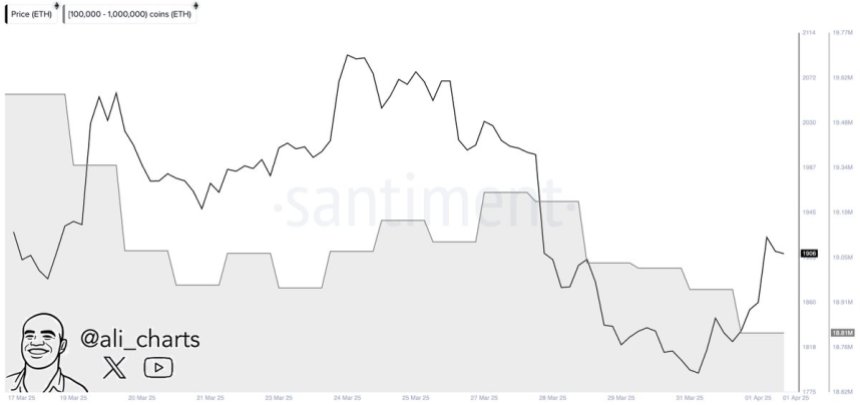
Still, markets are dynamic, and this trend could shift quickly. If Ethereum can hold key support zones and macroeconomic conditions begin to calm, the same large players currently selling may reenter the market in anticipation of the next rally. For now, though, Ethereum remains in a fragile state, with continued selling and cautious sentiment likely to dominate the short-term outlook. Bulls must step in soon to shift the trend — or risk watching ETH slide further in the weeks ahead.
Related Reading
Bulls Struggle to Reclaim Key Levels
Ethereum is currently trading at $1,880 after several days of weak price action, caught in a tight range between $2,000 resistance and $1,750 support. Despite multiple attempts, bulls have failed to reclaim the critical $2,000–$2,200 zone — a level that would signal strength and potentially mark the beginning of a broader recovery phase. Instead, ETH remains trapped in a downtrend, with momentum continuing to favor the bears.
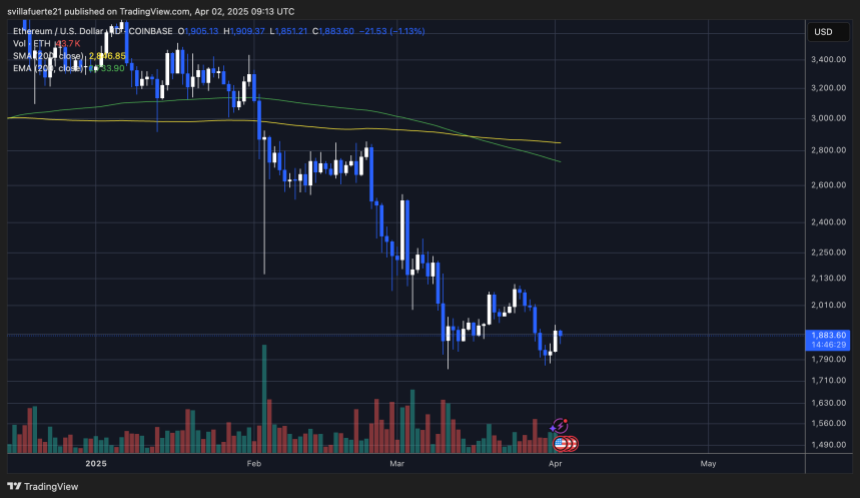
The inability to push higher is putting bulls in a vulnerable position. With Ethereum now hovering just below the $1,900 level, the coming days are crucial. If ETH fails to hold above this mark and cannot break back above $2,000 with conviction, a sharp drop is likely. Such a move could lead to a retest of the lower $1,700s or even deeper, especially if broader market sentiment remains negative.
Related Reading
As macroeconomic instability and market uncertainty persist, investors are growing cautious, and risk appetite continues to fade. For Ethereum to avoid a deeper selloff, bulls must step in quickly, reclaim lost ground, and reestablish confidence above the $2,000 level. Until then, the path of least resistance appears to remain to the downside.
Featured image from Dall-E, chart from TradingView
-

 Altcoin21 hours ago
Altcoin21 hours agoHere’s Why This Analyst Believes XRP Price Could Surge 44x
-

 Ethereum18 hours ago
Ethereum18 hours agoWhy A Massive Drop To $1,400 Could Rock The Underperformer
-

 Altcoin17 hours ago
Altcoin17 hours agoFirst Digital Trust Denies Justin Sun’s Allegations, Claims Full Solvency
-

 Altcoin20 hours ago
Altcoin20 hours agoHow Will Elon Musk Leaving DOGE Impact Dogecoin Price?
-

 Ethereum20 hours ago
Ethereum20 hours agoWhales Dump 760,000 Ethereum in Two Weeks — Is More Selling Ahead?
-

 Altcoin18 hours ago
Altcoin18 hours agoWill Cardano Price Bounce Back to $0.70 or Crash to $0.60?
-

 Market10 hours ago
Market10 hours agoXRP Price Under Pressure—New Lows Signal More Trouble Ahead
-

 Altcoin10 hours ago
Altcoin10 hours agoAnalyst Forecasts 250% Dogecoin Price Rally If This Level Holds






















